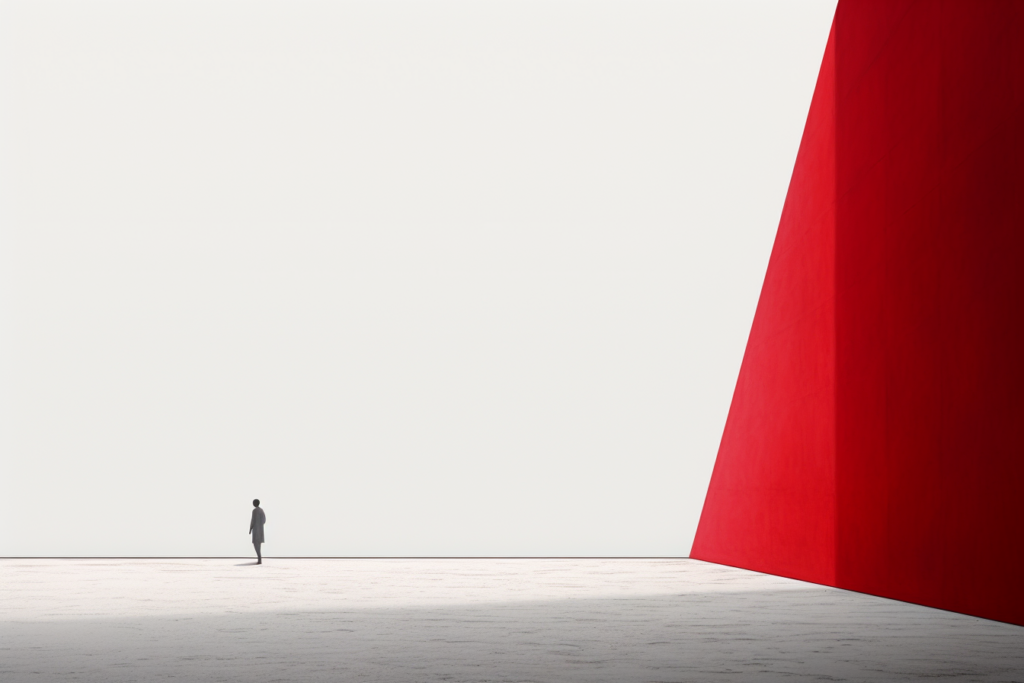13 Jaw-Dropping Facts About Minimalism
Ever felt like your closet is mocking you with the ‘I-have-nothing-to-wear’ paradox despite bursting at its seams?
Or maybe your phone is cluttered with apps you haven’t opened since 2017, and they have more memories than you.
Welcome to the jam-packed world of the 21st century.
That’s why, in today’s article, I will dive into the clear waters of Minimalism.
You will learn about…
- The true origins of Minimalism, and it’s not only art
- 13 Problematic facts of (Maximalism) and the benefits of Minimalism
- Is Minimalism anti-capitalist and free market?
- What would Minimalism do to economic growth if everybody went minimalist?
Let’s declutter, starting with 13 jaw-dropping facts about Minimalism that might just persuade you to give those neglected pants at the back of your closet a new home.
The True Origins of Minimalism
Contrary to what Britannica states about the origins of Minimalism, it’s not just an art movement.
It’s a philosophy, and its origins thus go farther back than 1919.
It stems from ancient philosophies, art movements, and modern adaptations.
Let’s find out what different origins of Minimalism there are…
Ancient Philosophies and Religions
There is Zen Buddhism (7th century Japan), which arises from Chinese Chan Buddhism.
It is flourishing, especially in Japan, underscores simplicity and contemplation.
As D.T. Suzuki, an early 20th-century Zen writer, mentioned, Zen’s aesthetic is seen in the way simplicity, asymmetry, and deep appreciation of inherent nature dominate its outlook. [Source: Zen and Japanese Culture by D.T. Suzuki].
Then there is Stoicism (3rd century BCE, Ancient Greece).
Thinkers like Seneca and Marcus Aurelius propagated the Stoic philosophy that cherishes living with virtue and wisdom.
Seneca said in his letters around 65 A.D., “It is not the man who has too little, but the man who craves more, that is poor.” [Source: Letters from a Stoic by Seneca].
By the way, in this article I compared Minimalism and Stoicism and identified common ground and differences.
Additional More Recent Philosophical Roots
Other philosophical roots come from more recent years.
One is the work of Henry David Thoreau, who wrote the book “Walden.”
In “Walden,” Thoreau describes his experiment of living in a cabin he built near Walden Pond in Concord, Massachusetts.
He lived there for two years, from 1845 to 1847, embracing a minimalist lifestyle to understand the essentials of life.
Thoreau wanted to “live deliberately,” stripping away the unnecessary complexities of society to gain a more profound understanding of life.
He believed in the virtues of simplicity and self-reliance.
While Thoreau didn’t use the term “minimalism” directly, his philosophy and the ethos he promoted in “Walden” align closely with various minimalism principles and what we understand as Minimalism today.
The famous line from the book, “Simplicity, simplicity, simplicity!” captures this sentiment. [Source: Walden by Henry David Thoreau, 1854]
Another “recent” philosopher or poet (well, a bit older than Thoreau) is Matsuo Bash Bashō (1644–1694).
He was a renowned Japanese poet, most famous for his haiku, a form of short poetry that captures the essence of a moment or observation in just three lines.
While Bashō wasn’t explicitly a “minimalist” in the modern sense of the term, many elements of his life and work resonate with the principles of Minimalism.
This form of poetry eliminates the unnecessary, focusing only on what’s essential.
Bashō lived a rather simple and austere life, especially during his travels.
He often relied on the generosity of patrons and friends or the little he earned from teaching and writing.
Minimalism often encourages a deeper connection with the natural world, valuing experiences over possessions.
Bashō’s poems frequently reflect moments of deep communion with nature, capturing the changing seasons, a frog jumping into an old pond, or the solitude of a moonlit night.
Bashō’s travels, especially those documented in “The Narrow Road to the Deep North,” can be seen as a journey towards greater self-understanding and enlightenment.
This journey wasn’t about acquiring more but deepening his understanding of the world and his place within it.
Bashō was influenced by Zen Buddhism.
As I outlined earlier, Zen Buddhism is one of Minimalism’s origins and values simplicity, mindfulness, and deep contemplation.
Zen, like Minimalism, encourages stripping away the unnecessary to find true essence and meaning.
In the broader context of Minimalism’s philosophical roots, Matsuo Bashō fits seamlessly.
His life and work encapsulate the search for meaning through simplicity and a profound appreciation of the present moment, both central tenets of Minimalism.
Arts and Architecture
Another origin of Minimalism lies in arts and architecture.
In traditional Japanese Architecture (pre-20th century Japan), the concept of “Ma” or “space/interval” is intrinsic to Japanese design.
This design principle states negative space is as significant as occupied space. [Source: In Praise of Shadows by Junichiro Tanizaki].
Then we have modern art and the minimalist movement (1960s, USA)
Pioneers like Donald Judd and Agnes Martin transitioned to more abstract forms, valuing the object’s inherent beauty.
The movement particularly gained traction in the 1960s and 1970s. [Source: Minimalism: Art and Polemics in the Sixties by James Meyer, 2001].
Also important to mention is minimalist music (1960s-1970s).
For instance, Steve Reich’s “Music for 18 Musicians” (1976) is a great example of how repetitive, essential melodies can create an immersive experience. [Source: Writings on Music by Steve Reich].
Probably more known to you is Minimalism in the Digital Age (21st century).
For instance, Cal Newport’s digital Minimalism (2019) breaks down the principles of living a focused life in a noisy world, suggesting ways to reduce digital distractions.
The next one is fashion (late 20th century onwards), exemplified by designers like Jil Sander and Helmut Lang.
They were less about trends and more about timeless, essential pieces. [Source: Fashion at the Edge by Caroline Evans].
Finally, the contemporary lifestyle movement (21st century) is expressed in books like Marie Kondo’s The Life-Changing Magic of Tidying Up (2011).
It reintroduced Minimalism as a lifestyle, emphasizing the joy of decluttering.
In conclusion, throughout history, different cultures, movements, and eras have cherished the principles of Minimalism in various forms.
Its essence lies in the belief that simplicity can pave the way to a fuller, richer life.
And as I hopefully could show you, its origins are more than just art.
13 Problematic Effects of (Maximalism) and the Benefits of Minimalism

You may have noted a pattern in some of the facts about the origins of Minimalism.
Pretty often, Minimalism is a vehicle or a solution to solve certain problems.
And these problems usually occur from “the man who craves more… (Seneca’s Letters 65 A.D.).”
Or, in other words, when this wanting more gets out of hand like an untrimmed tree.
You can call it Maximalism or uncontrolled consumerism.
From these negative effects of consumerism and materialism, you can, at the same derive the benefits of Minimalism.
So, let’s dive below into the problematic facts of Maximalism and consumerism and how they translate into the benefits of Minimalism.
1) Waste Overload
- The average American throws away about 100 pounds of clothing annually (source).
- Minimalism Benefit: Minimalism promotes owning and buying only what is necessary. This could substantially decrease the amount of clothing waste produced, hence reducing environmental harm.
2) Retail Therapy? & Retail Addiction
- Around 94% of Americans admit to impulse buying, with 64% regretting their purchases (source).
- “Oniomania,” or compulsive buying disorder, affects around 5-8% of the U.S. population (source).
- Minimalism Benefit 1: With improved financial stability and fewer impulse buys, minimalists often have more savings and less financial stress.
- Minimalism Benefit 2: Embracing Minimalism can relieve the urge to purchase constantly and mitigate disorders like “Oniomania.”
3) Digital Overload
- The average smartphone user checks their device 63 times daily (source).
- Minimalism Benefit: Enhanced mindfulness and presence by intentionally using and owning fewer digital devices, minimalists can spend more time in the present moment and have fewer distractions. And the latter can increase productivity.
4) Debt Rising
- The average U.S. household credit card debt is $5,733 (source). And on these charts, you can see how this debt has been rising.
- Minimalism Benefit: A minimalist lifestyle usually translates to fewer expenses and less reliance on credit, which can reduce debt levels.
5) Emotional Impact & Mental Health Concerns
- 55% of Americans report stress due to unwanted clutter. (source).
- High materialism has been linked to decreased life satisfaction (source).
- Minimalism Benefit: Mental clarity and peace with less clutter in their environment, many minimalists report a clearer mind and a sense of calm.
6) Fast Fashion Fallout
- A pair of jeans produces around 2,000 gallons of water (source).
- Minimalism Benefit: By opting for quality over quantity, minimalists support sustainable fashion, reducing water usage and environmental degradation
7) Gadget Graveyard
- 57.4 million metric tons of electronic waste was generated in 2021 (source).
- Minimalism Benefit: Owning fewer gadgets means fewer electronics end up as waste.
8) Food Waste
- In the U.S., an equivalent of 130 billion meals is wasted yearly. (source).
- Minimalism Benefit: By purchasing and consuming only what’s necessary, minimalists can contribute to reduced food waste.
9) Social Comparisons
- Social media use often causes envy when users compare their lives to (the fake ones) of others. This fuels the desire to buy more (source).
- Minimalism Benefit: Minimalists often value experiences and personal growth rather than material possessions, leading to less comparison.
10) Plastic Overload
- Only 9% of plastic has ever been recycled. The rest is in landfills, oceans, or scattered worldwide (source).
- Minimalism Benefit: Eco-friendly living. Minimalists often opt for sustainable, reusable products, thereby reducing plastic waste.
11) Decreased Savings
- 40% of Americans cannot cover a $400 emergency expense (source).
- Minimalism Benefit: Increased savings and emergency preparedness. Minimalists often find they are better prepared for financial emergencies by living with less and spending less.
12) Health Implications
- Diseases of affluence stemming from sedentary, over-consumptive lifestyles are on the rise. This includes conditions like obesity, type 2 diabetes, and certain cancers (source).
- Minimalism Benefit: Less emphasis on over-consumption can lead to healthier choices, potentially reducing risks associated with diseases of affluence.
13) Fast Food Epidemic
Despite health concerns, 50 million Americans consume fast food daily (source).
Minimalism Benefit: With a more conscious approach to consumption, minimalists might opt for healthier, home-cooked meals over fast food.
In Summary:
As you can see, consumerism and following the maximalism path isn’t just about an overloaded closet—it’s a full-blown, multidimensional mammoth affecting our mental state, environment, and societal structures.
And applying minimalist principles can help mitigate these negative consequences.
Speaking of it, this leads me to…
Is Minimalism then Anti-Capitalist and Free Market?
The principles of Minimalism and the workings of free markets and capitalism are not mutually exclusive.
Here’s a bit of an explainer with a light-hearted sprinkle:
Not Anti-Capitalism, Just Conscious Capitalism
Minimalism doesn’t advocate for the end of capitalism.
Instead, it nudges people to be more conscious about their consumption.
Think of it as “capitalism with a conscience.” Or, in other words, no automatic consumption zombies.
So, free markets are awesome. However, buying three of the same toasters because a T.V. commercial told you to?
Maybe not so awesome.
Quality over Quantity
Free markets thrive when they offer quality products that consumers value.
Minimalists usually love quality.
Instead of buying cheap products that break easily (and often), minimalists might invest in one high-quality item that lasts longer.
It is good for the environment and, in the long run, for the wallet.
Supply and Demand Still Rocks
Minimalism affects demand but doesn’t eliminate it.
If more people lean towards Minimalism, markets will adjust.
Maybe fewer plastic toys and more sustainable and long-lasting goods.
Capitalism has always been about adapting to consumer needs, and it’ll keep doing so.
By the way, even if you get officially rid of free markets (capitalism), it continues underground (e.g., black markets, prison inmates trading with each other, etc.).
The “Experiences Over Things” Economy
Look at the rise of the experience economy, from traveling to unique dining experiences.
That’s still a capitalist market. However, it’s a shifted one.
This shift would be from physical goods to memories and experiences.
The markets adjust to where the demand flows.
Not a Zero-Sum Game
Just because minimalists might spend less doesn’t mean they’re against economic growth or market systems.
They’re just participating in them differently, valuing long-term satisfaction over short-term impulses.
In a nutshell, Minimalism isn’t about dethroning capitalism.
It’s more like a friendly nudge, saying, “Hey, maybe we can do this capitalism thing a bit more mindfully…?”
What Would Minimalism Do to Economic Growth If Everybody Went Minimalist?
Let’s dive into how Minimalism could influence economic growth…This may actually be at the root of the earlier question regarding Minimalism being anti-capitalist.
Redefining Growth
First, who said growth always has to be about making more stuff?
How about better stuff, more innovative services, or improvements in quality of life?
Economic growth can be about depth, not just breadth.
Circular Economy Booms
Instead of the traditional “make, use, dispose” model (linear economy), there’s a push for a circular economy.
Here, products are designed for durability, reuse, and recycling.
This can lead to new job sectors and industries, spurring growth in more sustainable ways.
Investment in Experiences
As we mentioned, experiences are becoming the new bling (it’s Instagrammable).
Tourism, dining, art, education, and health and wellness industries could see an uptick.
This shift from products to experiences can foster growth in sectors previously overshadowed by mass consumerism.
Tech and Service Sectors Rise
With people buying less, there could be more emphasis on maintaining, repairing, and upgrading.
This leads to growth in the service, repair, and tech innovation industries.
Increase in Savings and Investments
People who spend less on consumables might invest more, increasing available capital.
This capital can be funneled into startups, research, and other growth-promoting sectors.
Local Business Flourish
Supporting local businesses can circulate money within communities, promoting localized economic growth and reducing the drain of funds to large (crony) corporations outside the community.
Environmental Cost Savings
A more sustainable and minimalist approach can reduce environmental degradation.
Think of the savings when we’re not spending huge amounts on disaster management, health costs from pollution, or importing resources because we’ve depleted our own.
Resource Efficiency
As Minimalism promotes the efficient use of resources, economies can benefit from reduced production costs and waste management.
This can make businesses more competitive and resilient.
Shift from Quantity to Value
Economies might move from being driven by volume to being driven by value.
This could lead to products and services that might be more expensive initially but are of higher quality, more durable, or offer unique features or experiences.
To boil it down, economic growth wouldn’t necessarily stop with Minimalism; it’d just change its stripes.
It’s like switching from fast fashion (which seems cheap but falls apart in a jiffy) to that timeless piece of clothing that might cost more but makes you feel like a million bucks and lasts way longer.
This article has been reviewed by our editorial team. It has been approved for publication per our editorial policy.

